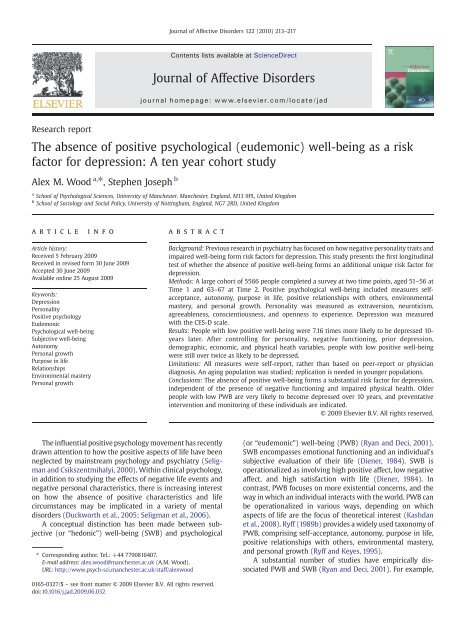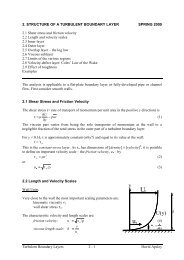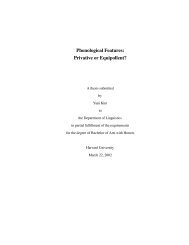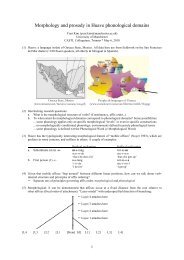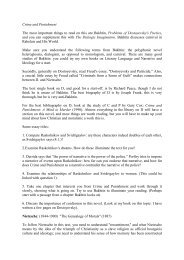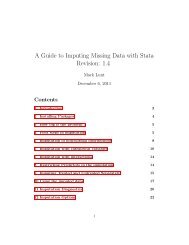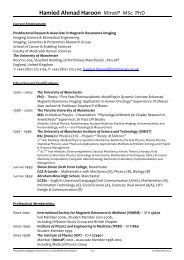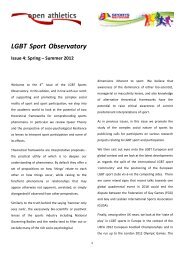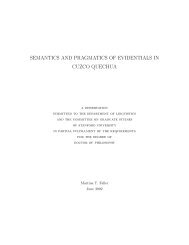The absence of positive psychological (eudemonic) well-being as a ...
The absence of positive psychological (eudemonic) well-being as a ...
The absence of positive psychological (eudemonic) well-being as a ...
You also want an ePaper? Increase the reach of your titles
YUMPU automatically turns print PDFs into web optimized ePapers that Google loves.
Research report<br />
<strong>The</strong> <strong>absence</strong> <strong>of</strong> <strong>positive</strong> <strong>psychological</strong> (<strong>eudemonic</strong>) <strong>well</strong>-<strong>being</strong> <strong>as</strong> a risk<br />
factor for depression: A ten year cohort study<br />
Alex M. Wood a, ⁎, Stephen Joseph b<br />
a School <strong>of</strong> Psychological Sciences, University <strong>of</strong> Manchester, Manchester, England, M13 9PL, United Kingdom<br />
b School <strong>of</strong> Sociology and Social Policy, University <strong>of</strong> Nottingham, England, NG7 2RD, United Kingdom<br />
article info abstract<br />
Article history:<br />
Received 5 February 2009<br />
Received in revised form 30 June 2009<br />
Accepted 30 June 2009<br />
Available online 25 August 2009<br />
Keywords:<br />
Depression<br />
Personality<br />
Positive psychology<br />
Eudemonic<br />
Psychological <strong>well</strong>-<strong>being</strong><br />
Subjective <strong>well</strong>-<strong>being</strong><br />
Autonomy<br />
Personal growth<br />
Purpose in life<br />
Relationships<br />
Environmental m<strong>as</strong>tery<br />
Personal growth<br />
<strong>The</strong> influential <strong>positive</strong> psychology movement h<strong>as</strong> recently<br />
drawn attention to how the <strong>positive</strong> <strong>as</strong>pects <strong>of</strong> life have been<br />
neglected by mainstream psychology and psychiatry (Seligman<br />
and Csikszentmihalyi, 2000). Within clinical psychology,<br />
in addition to studying the effects <strong>of</strong> negative life events and<br />
negative personal characteristics, there is incre<strong>as</strong>ing interest<br />
on how the <strong>absence</strong> <strong>of</strong> <strong>positive</strong> characteristics and life<br />
circumstances may be implicated in a variety <strong>of</strong> mental<br />
disorders (Duckworth et al., 2005; Seligman et al., 2006).<br />
A conceptual distinction h<strong>as</strong> been made between subjective<br />
(or “hedonic”) <strong>well</strong>-<strong>being</strong> (SWB) and <strong>psychological</strong><br />
⁎ Corresponding author. Tel.: +44 7790816407.<br />
E-mail address: alex.wood@manchester.ac.uk (A.M. Wood).<br />
URL: http://www.psych-sci.manchester.ac.uk/staff/alexwood<br />
0165-0327/$ – see front matter © 2009 Elsevier B.V. All rights reserved.<br />
doi:10.1016/j.jad.2009.06.032<br />
Journal <strong>of</strong> Affective Disorders 122 (2010) 213–217<br />
Contents lists available at ScienceDirect<br />
Journal <strong>of</strong> Affective Disorders<br />
journal homepage: www.elsevier.com/locate/jad<br />
Background: Previous research in psychiatry h<strong>as</strong> focused on how negative personality traits and<br />
impaired <strong>well</strong>-<strong>being</strong> form risk factors for depression. This study presents the first longitudinal<br />
test <strong>of</strong> whether the <strong>absence</strong> <strong>of</strong> <strong>positive</strong> <strong>well</strong>-<strong>being</strong> forms an additional unique risk factor for<br />
depression.<br />
Methods: A large cohort <strong>of</strong> 5566 people completed a survey at two time points, aged 51–56 at<br />
Time 1 and 63–67 at Time 2. Positive <strong>psychological</strong> <strong>well</strong>-<strong>being</strong> included me<strong>as</strong>ures selfacceptance,<br />
autonomy, purpose in life, <strong>positive</strong> relationships with others, environmental<br />
m<strong>as</strong>tery, and personal growth. Personality w<strong>as</strong> me<strong>as</strong>ured <strong>as</strong> extraversion, neuroticism,<br />
agreeableness, conscientiousness, and openness to experience. Depression w<strong>as</strong> me<strong>as</strong>ured<br />
with the CES-D scale.<br />
Results: People with low <strong>positive</strong> <strong>well</strong>-<strong>being</strong> were 7.16 times more likely to be depressed 10years<br />
later. After controlling for personality, negative functioning, prior depression,<br />
demographic, economic, and physical heath variables, people with low <strong>positive</strong> <strong>well</strong>-<strong>being</strong><br />
were still over twice <strong>as</strong> likely to be depressed.<br />
Limitations: All me<strong>as</strong>ures were self-report, rather than b<strong>as</strong>ed on peer-report or physician<br />
diagnosis. An aging population w<strong>as</strong> studied; replication is needed in younger populations.<br />
Conclusions: <strong>The</strong> <strong>absence</strong> <strong>of</strong> <strong>positive</strong> <strong>well</strong>-<strong>being</strong> forms a substantial risk factor for depression,<br />
independent <strong>of</strong> the presence <strong>of</strong> negative functioning and impaired physical health. Older<br />
people with low PWB are very likely to become depressed over 10 years, and preventative<br />
intervention and monitoring <strong>of</strong> these individuals are indicated.<br />
© 2009 Elsevier B.V. All rights reserved.<br />
(or “<strong>eudemonic</strong>”) <strong>well</strong>-<strong>being</strong> (PWB) (Ryan and Deci, 2001).<br />
SWB encomp<strong>as</strong>ses emotional functioning and an individual's<br />
subjective evaluation <strong>of</strong> their life (Diener, 1984). SWB is<br />
operationalized <strong>as</strong> involving high <strong>positive</strong> affect, low negative<br />
affect, and high satisfaction with life (Diener, 1984). In<br />
contr<strong>as</strong>t, PWB focuses on more existential concerns, and the<br />
way in which an individual interacts with the world. PWB can<br />
be operationalized in various ways, depending on which<br />
<strong>as</strong>pects <strong>of</strong> life are the focus <strong>of</strong> theoretical interest (K<strong>as</strong>hdan<br />
et al., 2008). Ryff (1989b) provides a widely used taxonomy <strong>of</strong><br />
PWB, comprising self-acceptance, autonomy, purpose in life,<br />
<strong>positive</strong> relationships with others, environmental m<strong>as</strong>tery,<br />
and personal growth (Ryff and Keyes, 1995).<br />
A substantial number <strong>of</strong> studies have empirically dissociated<br />
PWB and SWB (Ryan and Deci, 2001). For example,
214 A.M. Wood, S. Joseph / Journal <strong>of</strong> Affective Disorders 122 (2010) 213–217<br />
the PWB and SWB load on correlated but separate factors<br />
(Keyes et al., 2002; McGregor and Little, 1998; Ryff and Keyes,<br />
1995), and have different patterns <strong>of</strong> <strong>psychological</strong> (Waterman,<br />
1993) and biological (Ryff et al., 2006) correlates. PWB<br />
and SWB can also be dissociated on the individual level; about<br />
45% <strong>of</strong> people are “<strong>of</strong>f diagonal”, scoring high on PWB and low<br />
on SWB, or vice versa (Keyes et al., 2002). PWB h<strong>as</strong> been<br />
described <strong>as</strong> incorporating inherently <strong>positive</strong> <strong>psychological</strong><br />
concepts (Ryan and Deci, 2001; Ryff, 1989b; Ryff et al., 2006)<br />
(Riediger and Freund, 2004), <strong>as</strong> the constructs involve a life<br />
lived to the full, which is conducted in a socially constructive<br />
manner, and in line with a person's b<strong>as</strong>ic needs.<br />
Variables within the PWB construct have traditionally<br />
been considered important by various counseling psychology<br />
perspectives (M<strong>as</strong>low, 1970; Rogers, 1959, 1964; Yalom,1980).<br />
However, research in psychology and psychiatry h<strong>as</strong> almost<br />
exclusively focused on SWB, and related personality traits<br />
(trait <strong>positive</strong> and negative affects are respectively represented<br />
within extroversion and neuroticism). For example,<br />
depression h<strong>as</strong> been prospectively linked to extroversion and<br />
neuroticism (Barnett and Gotlib, 1988), and negative life<br />
evaluations (e.g., Evans et al., 2005). However, the dissociation<br />
between PWB and SWB suggests that PWB may be able to<br />
predict additional variance in clinical functioning above the<br />
<strong>positive</strong> and negative functioning represented in extroversion<br />
and neuroticism.<br />
PWB h<strong>as</strong> only recently attracted sustained empirical<br />
attention and h<strong>as</strong> become the focus <strong>of</strong> clinical treatments<br />
(Ryan and Deci, 2001). Indeed, PWB is strongly correlated<br />
with depression (Ryff, 1989a; Ryff and Keyes, 1995; Ryff et al.,<br />
1994), suggesting that people who are low in PWB may be at<br />
risk <strong>of</strong> developing the disorder. On this b<strong>as</strong>is, interventions to<br />
incre<strong>as</strong>e PWB are rapidly <strong>being</strong> developed, both for the<br />
prevention and treatment <strong>of</strong> depression (Fava, 1999; Fava<br />
et al., 1998; Seligman et al., 2005). Incre<strong>as</strong>ingly, these<br />
interventions are <strong>being</strong> used in mainstream clinical practice<br />
(Duckworth et al., 2005).<br />
Despite the incre<strong>as</strong>ing influence <strong>of</strong> <strong>positive</strong> psychology on<br />
clinical practice, some b<strong>as</strong>ic questions remain unanswered. It<br />
is not clear whether the <strong>absence</strong> <strong>of</strong> <strong>positive</strong> <strong>well</strong>-<strong>being</strong> can<br />
predict the clinically relevant levels <strong>of</strong> depression, or simply<br />
predict variance in sub-clinical melancholia. Additionally,<br />
most <strong>of</strong> the research h<strong>as</strong> been cross-sectional (Lazarus, 2003).<br />
This raises the possibility that impaired PWB is simply a<br />
consequence <strong>of</strong> depression, rather than implicated in the<br />
disorders etiology (Barnett and Gotlib, 1988).<br />
<strong>The</strong> current study tests for the first time whether people low<br />
in PWB are at risk for having clinically elevated levels <strong>of</strong><br />
depression ten years later. This study uses a large cohort sample<br />
<strong>of</strong> people initially aged 51–56, who completed me<strong>as</strong>ures again<br />
aged 63–67.IfpeoplelowinPWBareshowntobemorelikelyto<br />
be depressed in later life, then this would indicate the early<br />
intervention for these individuals <strong>as</strong> a preventative me<strong>as</strong>ure.<br />
1. Method<br />
We used data from the Wisconsin Longitudinal Survey, a<br />
cohort survey which began in 1957 with a random sample <strong>of</strong><br />
men and women graduating from Wisconsin high schools<br />
(Wisonsin Longitudinal Study, 2006). In 1992–1993 surviving<br />
participants were recontacted, and 6875 people completed an<br />
extensive mail questionnaire (Time 1). Ten years later, attempts<br />
were made to recontact participants. It w<strong>as</strong> not possible to<br />
contact 469 participants (6.8%) primarily due to mortality<br />
(N =406; 86.56%). Questionnaires were sent out to the<br />
remaining 6406 participants, <strong>of</strong> which 5778 provided responses<br />
(90.2%). A further 212 participants (3.3%) were excluded <strong>as</strong><br />
their responses contained substantial amounts <strong>of</strong> missing data<br />
(if participants had omitted only a few items on a given<br />
questionnaire, then the data w<strong>as</strong> inputted b<strong>as</strong>ed on their<br />
answers to the remaining items). This left 5566 participants<br />
completing me<strong>as</strong>ures at both time points, representing an<br />
overall retention rate <strong>of</strong> 81.0%. <strong>The</strong> end sample comprised 54.7%<br />
women, who were aged between 51 and 56 at the Time 1, and<br />
63 and 67 at Time 2, with a Time 1 mean household income <strong>of</strong><br />
US$67,194 (SD=$45,544) and <strong>as</strong>sets <strong>of</strong> US$229,549 (SD=<br />
$27,6440). Home ownership w<strong>as</strong> 91.2%, and vehicle ownership<br />
at 97.2%. Most <strong>of</strong> the samples were married (84.5%) and<br />
employed (65.7%), and 11.7% were retired.<br />
Participants completed the Centre for Epidemiologic Studies<br />
Depression (CES-D) me<strong>as</strong>ure at both time points (Radl<strong>of</strong>f,<br />
1977). <strong>The</strong> CES-D <strong>as</strong>sesses the presence <strong>of</strong> current depression<br />
by <strong>as</strong>king participants to rate how frequently in the l<strong>as</strong>t seven<br />
days they have experienced 20 symptoms <strong>of</strong> depression (e.g.,<br />
“have crying spells”). Responses range from 0 (“zero days”)to7<br />
(“seven days”). Responses are recoded 0 (b1day),1(1–2days),<br />
2(3–4 days), or 3 (5–7 days), and the overall score ranges from<br />
0 to 60. <strong>The</strong> CES-D w<strong>as</strong> originally developed for screening for<br />
depression in population surveys (Radl<strong>of</strong>f, 1977), and is one <strong>of</strong><br />
the five most widely used scales in both b<strong>as</strong>ic science and<br />
treatment outcome research (Santor et al., 2006). At a cut-<strong>of</strong>f<br />
value <strong>of</strong> 16, the CES-D h<strong>as</strong> a very high level <strong>of</strong> convergence with<br />
clinician ratings <strong>of</strong> depression (McDo<strong>well</strong> and Kristjansson,<br />
1996), demonstrating a sensitivity <strong>of</strong> 100% and a specificity <strong>of</strong><br />
88% in older populations (Beekman et al., 1997).<br />
At Time 1 (T1) participants also completed the 18-item<br />
version <strong>of</strong> the Scales <strong>of</strong> Psychological Well-<strong>being</strong> (Ryff and<br />
Keyes, 1995), which provides an overall PWB score, <strong>as</strong> <strong>well</strong> <strong>as</strong><br />
six sub-scales comprising self-acceptance, autonomy, purpose<br />
in life, <strong>positive</strong> relationships with others, environmental<br />
m<strong>as</strong>tery, and personal growth. <strong>The</strong> independence <strong>of</strong> these<br />
sub-scales h<strong>as</strong> been questioned (Springer and Hauser, 2006),<br />
however five recent factor analysis studies have supported<br />
the six factor structure <strong>of</strong> the Scales <strong>of</strong> Psychological Well<strong>being</strong><br />
(Ryff and Singer, 2006). Several studies have shown<br />
that a single higher order PWB factor exists above the subscales<br />
(e.g., Keyes et al., 2002; Ryff and Keyes, 1995), and<br />
previous research h<strong>as</strong> either used the sub-scales individually<br />
(e.g., McGregor and Little, 1998; Ryff et al., 2006; Wood et al.,<br />
2009) or <strong>as</strong> a total PWB score (Marmot et al., 1997; Riediger<br />
and Freund, 2004; Taylor et al., 2003). In the current study we<br />
conducted analysis at both the total and individual PWB level.<br />
Various demographic, economic, health, and personality<br />
variables were also included at T1 for use <strong>as</strong> covariates.<br />
Demographic and economic me<strong>as</strong>ures included sex, marriage,<br />
years <strong>of</strong> education, economic status (household <strong>as</strong>sets, combined<br />
personal and partner income, home ownership, and motor<br />
vehicle ownership), current employment, and retirement.<br />
Personality w<strong>as</strong> me<strong>as</strong>ured with reference to the Big Five model<br />
<strong>of</strong> personality (Watson et al., 1994). In this model, all personality<br />
traits are represented at the broadest level <strong>of</strong> abstraction with the<br />
five traits <strong>of</strong> extraversion, agreeableness, conscientiousness,
neuroticism, and openness. <strong>The</strong> Big Five provide the dominant<br />
model <strong>of</strong> personality within psychology, and the primacy <strong>of</strong> these<br />
traits h<strong>as</strong> been supported by a large number <strong>of</strong> factor analytical<br />
studies using all <strong>of</strong> the traits listed in comprehensive dictionaries<br />
in several languages (McCrae and Costa, 1987; Watson et al.,<br />
1994). <strong>The</strong>se traits were me<strong>as</strong>ured with the 44-item Big Five<br />
Inventory (John and Sriv<strong>as</strong>tava, 1999), which <strong>as</strong>ks participants to<br />
rate a series <strong>of</strong> statements about their personality on a 1 (“agree<br />
strongly”)to6(“disagree strongly”)scale.Previousresearchh<strong>as</strong><br />
demonstrated high test–retest reliability (r=.80to.90overthree<br />
months), good convergence with other me<strong>as</strong>ures <strong>of</strong> the Big Five<br />
(corrected r=.83–.99), and external correlations with peer<br />
ratings (John and Sriv<strong>as</strong>tava, 1999).<br />
Participants were also <strong>as</strong>ked whether they had been<br />
diagnosed by a medical pr<strong>of</strong>essional <strong>as</strong> having one <strong>of</strong> 16<br />
health conditions (anemia, <strong>as</strong>thma, arthritis, bronchitis/<br />
emphysema, cancer, chronic liver trouble, diabetes, serious<br />
back trouble, heart trouble, high blood pressure, circulation<br />
problems, kidney or bladder problems, ulcer, allergies, multiple<br />
sclerosis, and colitis). Each participant w<strong>as</strong> questioned<br />
separately about each condition and additionally <strong>as</strong>ked<br />
whether they had an illness not mentioned (only 31<br />
participants listed a separate illness, suggesting the list <strong>of</strong><br />
illnesses were comprehensive).<br />
<strong>The</strong> analysis w<strong>as</strong> designed to test whether people who<br />
were low in PWB when aged 51–56 were more at risk <strong>of</strong> <strong>being</strong><br />
depressed when aged 63–67. In all analysis, T2 CES-D scores<br />
were dichotomized into 0 “not depressed” or 1 “depressed”<br />
b<strong>as</strong>ed on the clinical cut-<strong>of</strong>f score <strong>of</strong> 16. Responses to the<br />
scales <strong>of</strong> PWB were split into tertiles. <strong>The</strong> highest tertile w<strong>as</strong><br />
designated normal functioning, with the medium tertiles<br />
indicating slightly impaired PWB, and the lowest tertile<br />
indicating low PWB. Several logistic regressions were performed<br />
with the normal level <strong>of</strong> PWB designated <strong>as</strong> the<br />
reference category. Each <strong>of</strong> the these logistic regressions w<strong>as</strong><br />
designed to test whether people with low PWB at Time 1<br />
were more at risk <strong>of</strong> <strong>being</strong> depressed at Time 2. <strong>The</strong> several<br />
logistic regressions differed b<strong>as</strong>ed on whether T1 depression<br />
w<strong>as</strong> <strong>being</strong> predicted from an overall PWB score or one <strong>of</strong> the<br />
sub-scales, and whether or not covariates were included in<br />
the model. Covariates included all <strong>of</strong> the demographic,<br />
medical, and economic variables detailed above, <strong>as</strong> <strong>well</strong> <strong>as</strong><br />
T1 levels <strong>of</strong> depression. T1 depression w<strong>as</strong> included <strong>as</strong> a<br />
continuous variable to fully control for variation in how close<br />
participants were to meeting the criteria for depression at T1<br />
(how close they were to the cut-<strong>of</strong>f point on the CES-D). This<br />
analysis had two purposes (a) to control for prior levels <strong>of</strong><br />
depression, and (b) to control for the relationship between T1<br />
depression and T1 PWB. With T1 depression controlled, any<br />
prediction <strong>of</strong> T2 depression from T1 PWB must be due to the<br />
variance in T1 PWB which is not shared with T1 depression.<br />
This rules out the possibility that any relationship between T1<br />
PWB and T2 depression is simply due to shared variance<br />
between PWB and depression (or similar explanations such<br />
<strong>as</strong> overlapping item content) (see Zapf et al., 1996).<br />
2. Results<br />
Overall, 12.98% <strong>of</strong> the sample w<strong>as</strong> depressed at T2. <strong>The</strong> first<br />
logistic regression predicted T2 depression from T1 overall<br />
PWB. Of people in the normal PWB tertile, 85 were depressed<br />
A.M. Wood, S. Joseph / Journal <strong>of</strong> Affective Disorders 122 (2010) 213–217<br />
at T2, compared to 177 in the impaired tertile, and 466 in the<br />
low tertile. People with low PWB were 7.16 (95% CI 5.63–9.12)<br />
times more likely to be depressed (pb.001). Consistently,<br />
people with slightly impaired PWB were 2.30 (95% CI 1.75–<br />
2.99) times more likely to be depressed (pb.001). This<br />
analysis suggests that people with impaired PWB are<br />
substantially more likely to be depressed 10 years later.<br />
<strong>The</strong> second logistic regression predicted T2 depression<br />
from T1 overall PWB, including all demographic, health, and<br />
personality variables <strong>as</strong> covariates, <strong>as</strong> <strong>well</strong> <strong>as</strong> T1 levels <strong>of</strong><br />
depression. <strong>The</strong>se results are presented in Table 1. Even<br />
though the effect sizes were considerably attenuated when<br />
including the covariates, low PWB at T1 still remained a<br />
substantial predictor <strong>of</strong> depression at T2, with people having<br />
low PWB <strong>being</strong> more than twice <strong>as</strong> likely to be depressed <strong>as</strong><br />
non-impaired individuals. Several <strong>of</strong> the medical disorders<br />
were also significant risk factors for depression, including<br />
serous back trouble, and circulation problems (OR 1.58–1.58);<br />
interestingly having low levels <strong>of</strong> PWB w<strong>as</strong> a greater risk<br />
factor for depression than these disorders. Low levels <strong>of</strong> PWB<br />
were a greater risk factor than <strong>being</strong> a standard deviation<br />
Table 1<br />
Logistic regression predicting Time 2 depression from b<strong>as</strong>eline levels <strong>of</strong> total PWB,<br />
depression, personality, demographic, economic, and health characteristics.<br />
OR<br />
95.0% CI<br />
Lower Upper<br />
Positive <strong>well</strong>-<strong>being</strong> (lowest tertile) 2.23 1.58 3.15<br />
Positive <strong>well</strong>-<strong>being</strong> (middle tertile) 1.58 1.15 2.18<br />
T1 depression 2.16 1.95 2.39<br />
Extraversion 1.00 0.90 1.12<br />
Agreeableness 0.92 0.83 1.02<br />
Conscientiousness 1.02 0.92 1.13<br />
Neuroticism 1.29 1.15 1.45<br />
Openness 1.03 0.92 1.15<br />
Female 0.75 0.60 0.92<br />
Married 0.91 0.70 1.20<br />
Years <strong>of</strong> education 0.96 0.91 1.01<br />
Employed 1.06 0.80 1.42<br />
Retired 1.26 0.95 1.68<br />
Household <strong>as</strong>sets 0.82 0.70 0.95<br />
Household income 0.92 0.80 1.07<br />
Home ownership 1.00 0.71 1.41<br />
Motor ownership 1.54 0.81 2.95<br />
Anemia 1.17 0.70 1.96<br />
Asthma 0.76 0.47 1.22<br />
Arthritis 1.04 0.83 1.29<br />
Bronchitis/emphysema 1.45 0.90 2.33<br />
Cancer 1.53 0.82 2.85<br />
Chronic liver trouble 1.49 0.46 4.81<br />
Diabetes 1.54 0.99 2.39<br />
Serious back trouble 1.48 1.10 1.99<br />
Heart trouble 1.27 0.85 1.90<br />
High blood pressure 1.04 0.83 1.30<br />
Circulation problems 1.58 1.08 2.30<br />
Kidney bladder problems 0.78 0.51 1.20<br />
Ulcer 1.56 1.00 2.46<br />
Allergies 1.29 0.99 1.67<br />
Multiple sclerosis 1.58 0.45 5.57<br />
Colitis 0.44 0.21 0.90<br />
Other illness 1.11 0.40 3.05<br />
Constant 1.370<br />
Note: Results in bold significant at pb.05, OR = odds ration; T1 depression<br />
and the Big Five are z-scored (odds ratio represents a one standard deviation<br />
incre<strong>as</strong>e in these variables).<br />
215
216 A.M. Wood, S. Joseph / Journal <strong>of</strong> Affective Disorders 122 (2010) 213–217<br />
higher on T1 depression or any personality trait (including<br />
neuroticism).<br />
Twelve more logistic regressions were performed, respectively<br />
regressing T2 separately on each <strong>of</strong> the six sub-scales <strong>of</strong><br />
PWB at T1, with and without covariates. (T2 depression w<strong>as</strong> not<br />
regressed jointly on all PWB sub-scales <strong>as</strong> substantial intercorrelations<br />
between the sub-scales introduced multicollinearity,<br />
thus violating the <strong>as</strong>sumptions <strong>of</strong> logistic regression.) Summary<br />
results are presented in Table 2. Without accounting for<br />
covariates, people with low levels <strong>of</strong> self-acceptance, autonomy,<br />
purpose in life, <strong>positive</strong> relationships with others, environmental<br />
m<strong>as</strong>tery, and personal growth were substantially more at risk for<br />
<strong>being</strong> depressed (OR 2.95–7.09). People with slightly impaired<br />
levels <strong>of</strong> these variables were also at risk (OR 1.40–2.39). After<br />
including all prior demographic, economic, personality, health,<br />
and depression statuses <strong>as</strong> covariates, people with low levels <strong>of</strong><br />
each <strong>of</strong> the PWB dimensions remained at a heightened risk <strong>of</strong><br />
<strong>being</strong> depressed (OR 1.32–2.08), although personal growth<br />
narrowly missed significance. People with slightly impaired<br />
levels <strong>of</strong> self-acceptance, autonomy, and purpose in life, and<br />
<strong>positive</strong> relationships were at a higher risk <strong>of</strong> depression (OR<br />
1.36–1.61) with a full set <strong>of</strong> covariates.<br />
3. Discussion<br />
<strong>The</strong> results suggest that people with low levels <strong>of</strong> <strong>positive</strong><br />
<strong>well</strong>-<strong>being</strong> are at a substantially higher risk from <strong>being</strong><br />
depressed 10 years later. Previous work in psychiatry h<strong>as</strong><br />
focused almost exclusively on how the presence <strong>of</strong> negative<br />
<strong>well</strong>-<strong>being</strong> forms a risk factor for depression (Barnett and<br />
Gotlib, 1988; Duckworth et al., 2005). Whilst replicating these<br />
results, the current study shows that the <strong>absence</strong> <strong>of</strong> <strong>positive</strong><br />
<strong>well</strong>-<strong>being</strong> also strongly predicts depression, even after<br />
controlling for the presence <strong>of</strong> neuroticism, medical conditions,<br />
and economic status. It w<strong>as</strong> also notable that PWB<br />
predicted depression above the personality trait <strong>of</strong> agreeableness.<br />
As agreeableness includes trait differences in<br />
Table 2<br />
Summary <strong>of</strong> six logistic regressions predicting Time 2 depression from b<strong>as</strong>eline levels <strong>of</strong> six <strong>as</strong>pects <strong>of</strong> PWB.<br />
<strong>positive</strong> affect, this suggests the effects <strong>of</strong> PWB are due to<br />
the specific <strong>as</strong>pects <strong>of</strong> these variables, rather than the habitual<br />
experiencing <strong>of</strong> <strong>positive</strong> moods.<br />
This is the first study to suggest that PWB predicts future<br />
depression. People with lower PWB were at risk <strong>of</strong> <strong>being</strong><br />
depressed regardless <strong>of</strong> whether PWB is <strong>as</strong>sessed <strong>as</strong> a global<br />
construct, or separately <strong>as</strong> self-acceptance, autonomy, purpose<br />
in life, <strong>positive</strong> relationships with others, environmental<br />
m<strong>as</strong>tery, and personal growth. This provides support for the<br />
<strong>positive</strong> clinical psychology movement (Duckworth et al.,<br />
2005), which suggests that <strong>as</strong>pects <strong>of</strong> <strong>positive</strong> <strong>psychological</strong><br />
<strong>well</strong>-<strong>being</strong> are important to understanding disorder, and<br />
supports the interventions which are <strong>being</strong> developed to<br />
incre<strong>as</strong>e PWB <strong>as</strong> a means <strong>of</strong> preventing and treating depression.<br />
<strong>The</strong> results suggest the relevance <strong>of</strong> the concept <strong>of</strong> PWB to<br />
psychiatry and medicine. <strong>The</strong> size <strong>of</strong> the odds ratios w<strong>as</strong><br />
striking. People low in PWB were over seven times more<br />
likely to be more depressed ten years later. Even after<br />
controlling for prior levels <strong>of</strong> depression, personality, demographics,<br />
and medical conditions, people with low PWB were<br />
still over twice <strong>as</strong> likely to be depressed in the future. This<br />
suggests that the improvement <strong>of</strong> PWB may be a legitimate<br />
public policy aim, and <strong>of</strong> medical significance in that it may<br />
prevent depression. This finding bolsters calls for a focus on<br />
developing PWB within the populations, such <strong>as</strong> within<br />
school settings (Ruini et al., 2006).<br />
<strong>The</strong> study had a couple <strong>of</strong> key limitations. First, the study<br />
relied on self-report, rather than physician ratings <strong>of</strong> depression.<br />
However, the CES-D depression h<strong>as</strong> previously been<br />
shown to substantially converge with physician ratings in<br />
older populations (at a sensitivity <strong>of</strong> 100% and a specificity <strong>of</strong><br />
88%) (Beekman et al., 1997). Second, the study examined a<br />
single cohort <strong>of</strong> people initially aged mid-50s, with a 10 year<br />
follow-up. More research is needed to show these findings<br />
generalize to other age groups, particularly if interventions to<br />
develop PWB are aimed at particular age groups (such <strong>as</strong><br />
within schools).<br />
Zero-order Adjusted<br />
No. <strong>of</strong> people depressed at T2 OR 95.0% CI OR 95.0% CI<br />
Low self-acceptance 467 7.09 5.55 9.07 2.08 1.51 2.87<br />
Impaired self-acceptance 183 2.39 1.83 3.13 1.61 1.17 2.20<br />
Normal self-acceptance 81 1.00<br />
Low autonomy 402 3.45 2.77 4.31 1.58 1.18 2.11<br />
Impaired autonomy 225 1.82 1.44 2.31 1.44 1.08 1.91<br />
Normal self-acceptance 111 1.00<br />
Low purpose in life 445 6.05 4.72 7.76 1.85 1.33 2.57<br />
Impaired purpose in life 206 2.34 1.79 3.06 1.69 1.23 2.31<br />
Normal self-acceptance 80 1.00<br />
Low <strong>positive</strong> relationships 431 4.26 3.42 5.32 1.96 1.45 2.65<br />
Impaired <strong>positive</strong> relationships 191 1.70 1.33 2.16 1.36 1.01 1.81<br />
Normal self-acceptance 110 1.00<br />
Low environmental m<strong>as</strong>tery 482 5.92 4.71 7.45 1.74 1.28 2.37<br />
Impaired environmental m<strong>as</strong>tery 160 1.88 1.45 2.44 1.29 0.95 1.75<br />
Normal self-acceptance 96 1.00<br />
Low personal growth 397 2.95 2.40 3.61 1.32 0.99 1.76<br />
Impaired personal growth 200 1.40 1.12 1.75 1.06 0.80 1.40<br />
Normal personal growth 140 1.00<br />
Note: results in bold significant at pb.05; df varies slightly due to missing data. <strong>The</strong> Normal tertile w<strong>as</strong> specified <strong>as</strong> the reference category. Adjusted odd ratios<br />
include all covariates listed in Table 1 (including T1 depression, personality, demographic variables, and physical health).
<strong>The</strong> study provides the first test <strong>of</strong> whether low PWB is a<br />
risk factor for future depression. <strong>The</strong> results suggest that in<br />
addition to having negative characteristics, the <strong>absence</strong> <strong>of</strong><br />
<strong>positive</strong> characteristics forms an additional (and substantial)<br />
risk factor for depression. This suggests that the alleviation <strong>of</strong><br />
low PWB can be a preventative me<strong>as</strong>ure for depression, and<br />
alleviating low PWB in psychiatric practice could potentially<br />
form an innovative new cure for depression. In primary care,<br />
older people with low PWB should be seen <strong>as</strong> highly at risk <strong>of</strong><br />
<strong>being</strong> depressed over a ten year period.<br />
Role <strong>of</strong> funding source<br />
Nothing declared.<br />
Conflict <strong>of</strong> interest<br />
<strong>The</strong> authors do not have any conflicts <strong>of</strong> interest.<br />
Acknowledgements<br />
This research uses data from the Wisconsin Longitudinal<br />
Study (WLS) <strong>of</strong> the University <strong>of</strong> Wisconsin-Madison. A public<br />
use file <strong>of</strong> data from the Wisconsin Longitudinal Study is<br />
available from the Wisconsin Longitudinal Study, University <strong>of</strong><br />
Wisconsin-Madison, 1180 Observatory Drive, Madison, Wisconsin<br />
53706 and at http://www.ssc.wisc.edu/wlsresearch/<br />
data/. <strong>The</strong> opinions expressed herein are those <strong>of</strong> the authors.<br />
We would like to thank all <strong>of</strong> the investigators, and Chris Boyce<br />
(Univ. Warwick) for his comments on the results.<br />
References<br />
Barnett, P.A., Gotlib, I.H., 1988. Psychosocial functioning and depression —<br />
distinguishing among antecedents, concomitants, and consequences.<br />
Psychological Bulletin 104, 97–126.<br />
Beekman, A.T.F., Deeg, D.J.H., VanLimbeek, J., Braam, A.W., DeVries, M.Z.,<br />
VanTilburg, W., 1997. Criterion validity <strong>of</strong> the Center for Epidemiologic<br />
Studies Depression scale (CES-D): results from a community-b<strong>as</strong>ed<br />
sample <strong>of</strong> older subjects in the Netherlands. Psychological Medicine 27,<br />
231–235.<br />
Diener, E., 1984. Subjective <strong>well</strong>-<strong>being</strong>. Psychological Bulletin 95, 542–575.<br />
Duckworth, A.L., Steen, T.A., Seligman, M.E.P., 2005. Positive psychology in<br />
clinical practice. Annual Review <strong>of</strong> Clinical Psychology 1, 629–651.<br />
Evans, J., Heron, J., Lewis, G., Araya, R., Wolke, D., ALSPAC Study Team, 2005.<br />
Negative self-schem<strong>as</strong> and the onset <strong>of</strong> depression in women: longitudinal<br />
study. British Journal <strong>of</strong> Psychiatry 186, 302–307.<br />
Fava, G.A., 1999. Well-<strong>being</strong> therapy: conceptual and technical issues.<br />
Psychotherapy and Psychosomatics 68, 171–179.<br />
Fava, G.A., Rafanelli, C., Cazzaro, M., Conti, S., Grandi, S., 1998. Well-<strong>being</strong><br />
therapy. A novel psychotherapeutic approach for residual symptoms <strong>of</strong><br />
affective disorders. Psychological Medicine 28, 475–480.<br />
John, O.P., Sriv<strong>as</strong>tava, S., 1999. <strong>The</strong> Big Five Trait taxonomy: history,<br />
me<strong>as</strong>urement, and theoretical perspectives. In: Pervin, L.A., John, O.P.<br />
(Eds.), Handbook <strong>of</strong> Personality: <strong>The</strong>ory and Research (2nd ed.). Guilford<br />
Press, New York, NY, pp. 102–138.<br />
K<strong>as</strong>hdan, T.B., Bisw<strong>as</strong>-Diener, R., King, L., 2008. Reconsidering happiness: the<br />
costs <strong>of</strong> distinguishing between hedonics and eudaimonia. Journal <strong>of</strong><br />
Positive Psychology 3, 219–233.<br />
Keyes, C.L.M., Shmotkin, D., Ryff, C.D., 2002. Optimizing <strong>well</strong>-<strong>being</strong>: the<br />
empirical encounter <strong>of</strong> two traditions. Journal <strong>of</strong> Personality and Social<br />
Psychology 82, 1007–1022.<br />
Lazarus, R.S., 2003. Does the <strong>positive</strong> psychology movement have legs?<br />
Psychological Inquiry 14, 93–109.<br />
Marmot, M., Ryff, C.D., Bump<strong>as</strong>s, L.L., Shipley, M., Marks, N.F., 1997. Social<br />
inequalities in health: next questions and converging evidence. Social<br />
Science & Medicine 44, 901–910.<br />
M<strong>as</strong>low, A.H., 1970. Motivation and Personality. Harper & Row.<br />
A.M. Wood, S. Joseph / Journal <strong>of</strong> Affective Disorders 122 (2010) 213–217<br />
McCrae, R.R., Costa, P.T., 1987. Validation <strong>of</strong> the 5-Factor Model <strong>of</strong> personality<br />
across instruments and observers. Journal <strong>of</strong> Personality and Social<br />
Psychology 52, 81–90.<br />
McDo<strong>well</strong>, I., Kristjansson, E., 1996. Depression. In: McDo<strong>well</strong>, I., Ne<strong>well</strong>, C.<br />
(Eds.), Me<strong>as</strong>uring Health: A Guide to Rating Scales and Questionnaires,<br />
pp. 238–286.<br />
McGregor, I., Little, B.R., 1998. Personal projects, happiness, and meaning: on<br />
doing <strong>well</strong> and <strong>being</strong> yourself. Journal <strong>of</strong> Personality and Social Psychology<br />
74, 494–512.<br />
Radl<strong>of</strong>f, L.S., 1977. <strong>The</strong> CES-D scale: a self-report depression scale for research<br />
in the general population. Applied Psychological Me<strong>as</strong>urement 1,<br />
385–401.<br />
Riediger, M., Freund, A.M., 2004. Interference and facilitation among personal<br />
goals: differential <strong>as</strong>sociations with subjective <strong>well</strong>-<strong>being</strong> and persistent<br />
goal pursuit. Personality and Social Psychology Bulletin 30, 1511–1523.<br />
Rogers, C.R., 1959. A theory <strong>of</strong> therapy, personality and interpersonal relationships<br />
<strong>as</strong> developed in the client-centered framework. In: Koch, S. (Ed.),<br />
Psychology: A Study <strong>of</strong> a Science. McGraw-Hill Book Company, New York,<br />
pp. 181–256.<br />
Rogers, C.R., 1964. Toward a modern approach to values: the valuing process<br />
in the mature person. Journal <strong>of</strong> Abnormal and Social Psychology, 68,<br />
160–167.<br />
Ruini, C., Belaise, C., Brombin, C., Caffo, E., Fava, G.A., 2006. Well-<strong>being</strong><br />
therapy in school settings: a pilot study. Psychotherapy and Psychosomatics<br />
75, 331–336.<br />
Ryan, R.M., Deci, E.L., 2001. On happiness and human potentials: a review <strong>of</strong><br />
research on hedonic and eudaimonic <strong>well</strong>-<strong>being</strong>. Annual Review <strong>of</strong><br />
Psychology 52, 141–166.<br />
Ryff, C.D., 1989a. Beyond Deleon, Ponce and life satisfaction — new directions<br />
in quest <strong>of</strong> successful aging. International Journal <strong>of</strong> Behavioral<br />
Development 12, 35–55.<br />
Ryff, C.D., 1989b. Happiness is everything, or is it — explorations on the<br />
meaning <strong>of</strong> <strong>psychological</strong> <strong>well</strong>-<strong>being</strong>. Journal <strong>of</strong> Personality and Social<br />
Psychology 57, 1069–1081.<br />
Ryff, C.D., Keyes, C.L.M., 1995. <strong>The</strong> structure <strong>of</strong> <strong>psychological</strong> <strong>well</strong>-<strong>being</strong><br />
revisited. Journal <strong>of</strong> Personality and Social Psychology 69, 719–727.<br />
Ryff, C.D., Singer, B.H., 2006. Best news yet on the six-factor model <strong>of</strong> <strong>well</strong><strong>being</strong>.<br />
Social Science Research 35, 1103–1119.<br />
Ryff, C.D., Lee, Y.H., Essex, M.J., Schmutte, P.S., 1994. My children and me —<br />
midlife evaluations <strong>of</strong> grown children and <strong>of</strong> self. Psychology and Aging<br />
9, 195–205.<br />
Ryff, C.D., Love, G.D., Urry, H.L., Muller, D., Rosenkranz, M.A., Friedman, E.M.,<br />
Davidson, R.J., Singer, B., 2006. Psychological <strong>well</strong>-<strong>being</strong> and ill-<strong>being</strong>: do<br />
they have distinct or mirrored biological correlates? Psychotherapy and<br />
Psychosomatics 75, 85–95.<br />
Santor, D.A., Gregus, M., Welch, A., 2006. Eight decades <strong>of</strong> me<strong>as</strong>urement in<br />
depression. Me<strong>as</strong>urement 4, 135–155.<br />
Seligman, M.E.P., Csikszentmihalyi, M., 2000. Positive psychology: an<br />
introduction. American Psychologist 55, 5–14.<br />
Seligman, M.E.P., R<strong>as</strong>hid, T., Parks, A.C., 2006. Positive psychotherapy.<br />
American Psychologist 61, 774–788.<br />
Seligman, M.E.P., Steen, T.A., Park, N., Peterson, C., 2005. Positive psychology<br />
progress: empirical validation <strong>of</strong> interventions. American Psychologist<br />
60, 410–421.<br />
Springer, K.W., Hauser, R.M., 2006. An <strong>as</strong>sessment <strong>of</strong> the construct validity <strong>of</strong><br />
Ryff's Scales <strong>of</strong> Psychological Well-Being: method, mode, and me<strong>as</strong>urement<br />
effects. Social Science Research 35, 1080–1102.<br />
Taylor, S.E., Lerner, J.S., Sherman, D.K., Sage, R.M., McDo<strong>well</strong>, N.K., 2003. Are<br />
self-enhancing cognitions <strong>as</strong>sociated with healthy or unhealthy biological<br />
pr<strong>of</strong>iles? Journal <strong>of</strong> Personality and Social Psychology 85, 605–615.<br />
Waterman, A.S., 1993. Two conceptions <strong>of</strong> happiness — contr<strong>as</strong>ts <strong>of</strong> personal<br />
expressiveness (eudaimonia) and hedonic enjoyment. Journal <strong>of</strong><br />
Personality and Social Psychology 64, 678–691.<br />
Watson, D., Clark, L.A., Harkness, A.R., 1994. Structures <strong>of</strong> personality and<br />
their relevance to psychopathology. Journal <strong>of</strong> Abnormal Psychology 103,<br />
18–31.<br />
Wisonsin Longitudinal Study, 2006. Wisconsin Longitudinal Study Handbook<br />
2006. Wisconsin: University <strong>of</strong> Wisconsin Survey Center.<br />
Wood, A.M., Joseph, S., Maltby, J., 2009. Gratitude predicts <strong>psychological</strong> <strong>well</strong><strong>being</strong><br />
above the Big Five facets. Personality and Individual Differences 46,<br />
443–447.<br />
Yalom, I.D., 1980. Existential Psychotherapy. B<strong>as</strong>ic Books, New York.<br />
Zapf, D., Dormann, C., Frese, M., 1996. Longitudinal studies in organizational<br />
stress research: a review <strong>of</strong> the literature with reference to methodological<br />
issues. Journal <strong>of</strong> Occupational Health Psychology 1, 145–169.<br />
217


